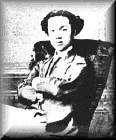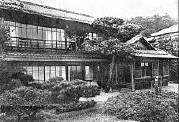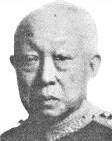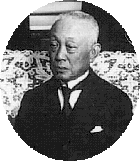



|
Shizuoka Profiles:
Saionji Kimmochi
Let's travel back a hundred years, to a time when the Tokaido rail line just connected Shizuoka prefecture to Tokyo. Japan's economy was shifting from agriculture to heavy industry.
Attracted to the mild climate and proximity to Tokyo, a number of wealthy Japanese built resorts around Okitsu, Haibara, and Numazu
during later the 19th Century. This article describes Saionji Kimmochi, a statesman who made the Okitsu area of Shizuoka his second home.
Born into the noble Fujiwara family at the twilight of the Tokugawa era, Saionji was raised as a Kyoto aristocrat. He fought against
pro-Tokugawa forces in Hokkaido in 1867 then studied law in France from 1871-1880.
After returning from Europe, Saionji became a member of the Privy Council, an advisory board for the Emperor. Influenced by the
democratic ideals of Emile Acollas and a love for law, he also founded Ritsumeikan University in 1871.
For a brief period Saionji became active in newspaper publishing. Freedom of the press was not a feature of the Meiji Constitution
and the government ordered him to cease publication. It appears Saionji was too progressive for his time. However, in his later years he gained a reputation as a moderate,
through clearly a member of the gentry.
Sent on a diplomatic mission to Europe in 1880, Saionji became ambassador to Austria, then Germany. Returning to Japan in 1896, Saionji
was then appointed Minister of Education. Soon after this he was elected President of the Privy Council. One of Saionji's achievements was in fostering the civil service.
During the early 1900's a power struggle developed between those who wanted Japan to become a constitutional democracy and those
favoring a strong central monarchy. Saionji, generally balanced in his views, favored a limited democracy. He also urged restraint in military expenditures.
Alternating as prime minister with Katsura Taro til 1912, Saionji's cabinet fell when he refused to grant the Army two additional
divisions and the Navy more battleships. Saionji, who complained bitterly in private about the rising influence of the armed forces,
was unable to actively stem the tide.
In 1918 Saionji became the Japanese plenipotentiary to the Paris Peace Conference. He was raised in rank from marquis
to prince. As an ambassador, he was effective in promoting good relations with the European powers of the day. It seems he was less effective when faced with complex domestic affairs.
In 1921 Prime Minister Hara, an important ally of Saionji, was assassinated. Soon after this, Yamagata and Matsukata -
the two other remaining genro passed away. Saionji became increasingly isolated and his political influence waned.
Though respected as an individual, it seemed Saionji lacked the clout, cunning, and stamina to be a powerful kingpin.
Spending his remaining years in Okitsu area of Shizuoka City, Saionji died in 1940. His villa is now on display at
Meiji Mura in Aichi Prefecture.
- Tim Newfields
|



